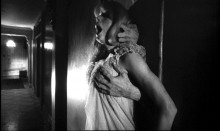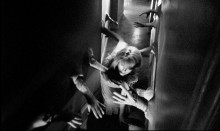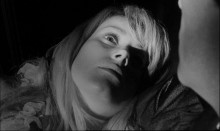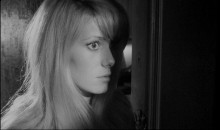Roman Polanski’s first English-language film, Repulsion (1965), is actually a picture the filmmaker undertook primarily in order to get financing for his next movie, Cul-de-sac (1966)—an approach that would continue to mark Polanski’s work over the years. The producers wanted something that could be marketed as an exploitation horror picture, and while Polanski complied, he did so by giving them a deeply disturbing examination of a young woman’s descent into madness such as had never been seen before. In other words, Polanski the pragmatist and Polanski the artist are on pretty even footing—here are your thrills, but on his terms as an artist.

The film follows a few days in the disintegrating life of Carole (Catherine Deneuve), a young foreign woman in London, who works as a manicurist and lives with her sister (Yvonne Furneaux). Outwardly, Carole seems a normal—if rather quiet and withdrawn—pretty girl. She has a job, a place to live, a family, even a sort of boyfriend (John Fraser). But it soon becomes apparent that she’s more than quiet and withdrawn. The easy answer to what’s wrong with Carole—and the one often given—is that she’s sexually repressed, and this is indeed made very clear. Everything that happens is tied to both her attraction and revulsion to sex.

This, however, is the easy answer that fails to take several other aspects of the film into consideration—the hints at an introversion of long-standing, her growing inability to connect with life and the world around her on any level (especially once she’s left alone for a few days), and the fact that she’s an immigrant. This last should not be undersold when approaching the film, since it is what makes the film personal to Polanski, who was twice an immigrant at this point—a Polish filmmaker who’d emigrated to France and was now making a movie in England. His own sense of being an outsider was almost certainly even greater, since he and his writing partner Gérard Brach had written the script in French and it had then been translated into English. Like Carole, he had a sense of not fitting in—and he’d already experienced it in France. This was, in fact, something Polanski would return to—with himself in the title role—in The Tenant (1976).

If it’s the sense of isolation that gives Repulsion its greatest resonance, it’s Polanski’s astonishing control of the medium of film that makes it all work. The apartment in which the bulk of the film takes place starts off as a perfectly common place, but it takes on an ever-increasing aura of the sinister as the movie progresses, which is to say as Carole becomes progressively demented. The very dimensions of the surroundings seem to change. What seemed a small room starts looking cavernous and menacing. A walk down a hallway becomes a trial—one that finally erupts into a delirium of molestation. Polanski conveys all this with a precision that’s still startling today—and still unsettling, not in the least because he offers no neat explanation.

Unlike Hitchcock’s Psycho (1960), where friendly psychiatrist Simon Oakland wanders in to put what just happened into comforting perspective for the viewer, Repulsion takes the viewer into the abyss and offers only the faintest glimmer of explanation. This comes by way of a family photograph that we’ve seen more than once, but that Polanski shows us more closely this time. Yet what does it tell us other than the madness had perhaps always been there? Nothing. And that’s what makes the film so uncomfortable.



This film has the creepiest endings ever and is in my top 20 of all time. Highly recommended!
Don’t miss this one!